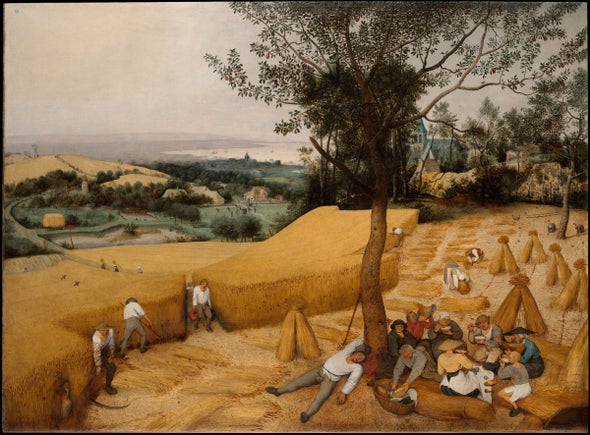(单词翻译:单击)
听力文本
This is Scientific American's 60-second Science, I'm Susanne Bard.
Pieter Bruegel's iconic 1565 painting The Harvesters hangs at the Metropolitan Museum of Art in New York City. The work depicts peasants cutting stalks of wheat nearly as tall as they are.
"Nowadays, if you walk through a wheat field, you basically see that wheat is about knee-height. The short stature is essentially a consequence of breeding from the second half of the 20th century."
University of Ghent biologist Ive De Smet.
Selective breeding favored genes for reduced height, because they came along with genes for increasing yields to feed a growing population. De Smet says wheat is just one example of how historical artwork can allow us to track the transformation of food crops over time. He teamed up with art historian David Vergauwen of Amarant to catalogue such artwork around the world.
"We have been mainly looking at things where we kind of can spot changes in shape, in color, in size."
Friends since childhood, their interest in plants in artwork began with a visit to the Hermitage Museum in St. Petersburg, Russia—where they noticed an odd-looking watermelon in an early-17th-century painting by Flemish artist Frans Snyders.
"So if you think of a watermelon, you cut it through, it should be dark red on the inside. But that one appeared to be pale and white."
Biologist De Smet assumed the painter had done a poor job. But art historian Vergauwen had a different idea.
"He says, 'No, this is one of the best painters ever from that era. So if he paints it like that, that's the way it must have looked like.'"

Other paintings revealed that both red and white watermelons were cultivated during the 17th century. The color is determined by a gene that controls the pigment lycopene.
"There must have been some sort of mutation preventing the accumulation of that color. Now, with all the genetic knowledge that we have from various plant species, we can look in more detail how something comes about."
For example, De Smet says carrots first started to be depicted as orange only in the 16th century, thanks to selective breeding for the beta-carotene pigment. And until the 18th century, European strawberries appear tiny in paintings—they then grew in size with the advent of crossbreeding with North American varieties.
The research is in the journal Trends in Plant Science.
Ultimately, the team hopes to create an online research database of historical plant artwork. They seek the contributions of art enthusiasts around the world via the social media hashtag #artgenetics. But, they caution, the source paintings need to be realistic.
"If you're going to use, for example, Picasso to try and understand how a pear looked in the early 20th century, you might be misled."
Indeed, such an attempt could be fruitless.
Thanks for listening for Scientific American's 60-second Science. I'm Susanne Bard.
参考译文
这里是科学美国人——60秒科学系列,我是苏珊娜·巴德。
彼得·勃鲁盖尔1565年所作标志性画作《收割者》挂在纽约大都会艺术博物馆。这部作品描绘的是农民在收割几乎和他们一样高的小麦麦秆。
“现在,如果你走过小麦田,看到的小麦大概只到膝盖。这种矮小身材本质上是20世纪下半叶育种的结果。”
根特大学的生物学家伊夫·德斯密特说到。
选择育种偏爱矮秆基因,因为它们会随着增产基因一同出现,以养活日益增加的人口。德斯密特表示,小麦只是一个例子,说明历史美术品如何让我们追踪粮食作物随时间变化。他与阿马兰特的艺术历史学家大卫·韦高文合作,将全世界的此类艺术伤口进行了分类。
“我们主要观察我们可以察觉到的形状、颜色、大小变化的东西。”
二人从小就是朋友,在参观完俄罗斯圣彼得堡艾尔米塔什博物馆后开始对艺术作品中的植物感兴趣,他们在博物馆注意到17世纪早期佛兰芒艺术家弗兰斯·斯奈德画的西瓜有点奇怪。
“如果你认为那是西瓜,切开它,里面的瓤应该是暗红色的。但画中的看上去是灰白的白色。”
生物学家德斯密特猜测画家画错了。但是艺术史学家韦高文有不同的想法。
“他表示,‘不对,他是那个时代最好的画家之一。所以如果他那样画,那肯定就是这样的。’”
其他画作显示,17世纪有种植红色和白色的西瓜。颜色由控制番茄红素的基因决定。
“一定是某种变异阻止了这种颜色的积累。现在,我们掌握了各种植物的遗传知识,可以详细分析某种现象是如何发生的。”
德斯密特表示,例如,由于β-胡萝卜素色素的选择性繁殖,胡萝卜只在16世纪被描绘成橙色。直到18世纪,欧洲草莓在画作中仍显得很小,之后随着与北美品种杂交的出现,草莓的大小也随之增长。
这项研究发表在《植物科学趋势》期刊上。
最终,该团队希望建立一个历史植物艺术品在线研究数据库。他们可以通过社交媒体标签“艺术遗传学”来获得全世界艺术爱好者的艺术品。但是,他们警告称,绘画作品必须是写实的。
“比如说,如果你打算用毕加索的作品来尝试了解20世纪初梨子的样子,你可能会被误导。”
的确,这样的尝试可能毫无结果。
谢谢大家收听科学美国人——60秒科学。我是苏珊娜·巴德。
译文为可可英语翻译,未经授权请勿转载!
重点讲解
重点讲解:
1. team up with (与…)组队;(与…)协作;
They teamed up with Tom Jones to record the his single.
他们和汤姆·琼斯联手录制这首热门单曲。
2. come about 产生;发生;
Any possible solution to the Irish question can only come about through dialogue.
任何解决爱尔兰问题的可行方案只能通过对话产生。
3. despict as 描绘;描画;
Children's books often depict farmyard animals as gentle, lovable creatures.
儿童图书常常把农场的动物描写得温和而可爱。
4. thanks to 幸亏;归因于;
Thanks to the automobile, Americans soon had a freedom of movement previously unknown.
由于有了汽车,美国人很快就获得了前所未有的行动自由。


